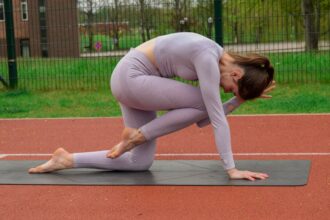Grounding techniques are essential tools that help you anchor yourself in the present moment, especially during times of stress or anxiety. These methods allow you to reconnect with your body and surroundings, providing a sense of stability and calm. When you feel overwhelmed, grounding techniques can serve as a lifeline, helping you regain control over your thoughts and emotions.
By focusing on the here and now, you can create a buffer against the chaos that life sometimes brings. You might find that grounding techniques vary widely, from simple breathing exercises to more complex practices involving mindfulness and sensory engagement. The beauty of these techniques lies in their adaptability; you can tailor them to fit your personal preferences and circumstances.
Whether you are at home, at work, or in a public space, grounding techniques can be employed to help you navigate through challenging moments. Understanding these methods is the first step toward incorporating them into your daily routine, ultimately enhancing your emotional resilience.
Key Takeaways
- Grounding techniques help to bring awareness to the present moment and create a sense of stability and security.
- A calm nervous system is essential for overall well-being and can be achieved through various relaxation techniques.
- Deep breathing exercises can help reduce stress and anxiety by activating the body’s relaxation response.
- Mindfulness and meditation practices can improve mental clarity and emotional resilience.
- Connecting with nature, engaging in physical activity, and using essential oils can all contribute to a sense of grounding and relaxation.
Importance of a Calm Nervous System
A calm nervous system is crucial for maintaining overall well-being. When your nervous system is in a state of balance, you are better equipped to handle stressors and challenges that life throws your way. A calm state allows for clearer thinking, improved decision-making, and a greater capacity for emotional regulation.
Conversely, when your nervous system is overstimulated or in a constant state of fight-or-flight, it can lead to feelings of anxiety, irritability, and even physical health issues. By prioritizing techniques that promote a calm nervous system, you can create a more harmonious internal environment. This not only benefits your mental health but also enhances your physical health.
You may notice improvements in sleep quality, digestion, and even immune function when you actively work to soothe your nervous system. Recognizing the importance of this balance empowers you to take proactive steps toward achieving a more peaceful state of being.
Deep Breathing Exercises

Deep breathing exercises are one of the simplest yet most effective grounding techniques available to you. By focusing on your breath, you can quickly shift your attention away from stressors and into a more relaxed state. When you take deep breaths, you activate the parasympathetic nervous system, which helps counteract the effects of stress and anxiety.
This physiological response can lead to a decrease in heart rate and blood pressure, promoting an overall sense of calm. To practice deep breathing, find a comfortable position—whether sitting or lying down—and close your eyes if it feels right. Inhale deeply through your nose for a count of four, allowing your abdomen to expand fully.
Hold that breath for a moment before exhaling slowly through your mouth for a count of six or eight. Repeat this cycle several times, focusing solely on the rhythm of your breath. As you engage in this practice, you may find that your mind begins to quiet, allowing you to feel more centered and grounded in the present moment.
Mindfulness and Meditation
| Category | Metrics |
|---|---|
| Usage | Number of people practicing mindfulness and meditation |
| Effectiveness | Reduction in stress levels |
| Health Benefits | Improvement in mental well-being |
| Research | Number of scientific studies on mindfulness and meditation |
Mindfulness and meditation are powerful practices that can significantly enhance your grounding techniques. Mindfulness involves paying attention to the present moment without judgment, while meditation often provides a structured way to cultivate this awareness. By incorporating these practices into your daily routine, you can develop a greater sense of self-awareness and emotional regulation.
To begin practicing mindfulness, start by observing your thoughts and feelings without trying to change them. You might choose to focus on your breath or the sensations in your body as you sit quietly. This practice encourages you to acknowledge whatever arises without becoming overwhelmed by it.
Over time, you may find that mindfulness helps you respond to stressors with greater clarity and calmness. Meditation can further deepen this experience by providing dedicated time for reflection and stillness, allowing you to cultivate a more profound sense of peace.
Connecting with Nature
Connecting with nature is another effective grounding technique that can help restore balance to your nervous system. Spending time outdoors allows you to immerse yourself in the natural world, which has been shown to have calming effects on both the mind and body. Whether it’s a walk in the park, hiking in the woods, or simply sitting in your backyard, nature provides an opportunity for rejuvenation and grounding.
As you engage with nature, take time to notice the sights, sounds, and smells around you. Feel the texture of leaves or the coolness of grass beneath your feet. This sensory engagement can help anchor you in the present moment and foster a sense of connection to something larger than yourself.
By making nature a regular part of your routine, you can cultivate a deeper appreciation for the world around you while simultaneously enhancing your emotional well-being.
Physical Activity and Exercise

Physical activity is an excellent way to ground yourself while also benefiting your overall health. Engaging in regular exercise releases endorphins—natural mood lifters—that can help alleviate feelings of anxiety and stress. Whether it’s a brisk walk, yoga session, or high-intensity workout, moving your body allows you to release pent-up energy and tension.
Incorporating physical activity into your daily routine doesn’t have to be daunting; even small bursts of movement can make a significant difference. Consider taking short breaks throughout the day to stretch or go for a quick walk outside. These moments not only provide physical benefits but also serve as grounding techniques that help clear your mind and refocus your energy.
By prioritizing movement, you create an opportunity for both mental clarity and emotional stability.
Using Essential Oils
Essential oils have gained popularity as natural remedies for promoting relaxation and grounding. These concentrated plant extracts can be used in various ways—such as through diffusion, topical application, or inhalation—to create calming environments that support emotional well-being. Scents like lavender, chamomile, and bergamot are particularly known for their soothing properties.
To incorporate essential oils into your grounding practice, consider creating a calming ritual that includes diffusing oils while engaging in deep breathing or meditation. Alternatively, you might apply diluted essential oils to pulse points on your wrists or neck before heading into stressful situations. The olfactory connection between scent and memory can evoke feelings of calmness and safety, making essential oils a valuable addition to your grounding toolkit.
Visualization and Guided Imagery
Visualization and guided imagery are powerful techniques that allow you to create mental images that promote relaxation and grounding. By picturing serene landscapes or peaceful scenarios in your mind’s eye, you can transport yourself away from stressors and into a place of tranquility. This practice engages both your imagination and senses, helping to foster a sense of calm.
To practice visualization, find a quiet space where you can sit comfortably with your eyes closed. Take several deep breaths to center yourself before imagining a peaceful scene—perhaps a beach at sunset or a quiet forest glade.
Allow yourself to fully immerse in this mental imagery for several minutes; this can serve as an effective escape from anxiety while also grounding you in the present moment.
Progressive Muscle Relaxation
Progressive muscle relaxation (PMR) is an effective technique that involves systematically tensing and relaxing different muscle groups throughout your body. This practice not only helps release physical tension but also promotes mental relaxation by encouraging mindfulness of bodily sensations. By focusing on each muscle group individually, you can cultivate greater awareness of how stress manifests physically.
To practice PMR, find a comfortable position where you can focus without distractions. Start at your feet by tensing the muscles for five seconds before releasing them completely. Gradually work your way up through each muscle group—calves, thighs, abdomen, arms—until you’ve covered your entire body.
As you release tension from each area, take note of how it feels to let go; this awareness can help reinforce feelings of relaxation and grounding.
Engaging the Senses
Engaging your senses is an effective way to ground yourself in the present moment while fostering emotional well-being. By focusing on what you see, hear, smell, taste, and touch, you can redirect your attention away from anxious thoughts and into the richness of your immediate environment. This sensory engagement serves as an anchor during times of stress.
Consider taking a moment to observe the colors around you or listen closely to ambient sounds—perhaps birds chirping or leaves rustling in the wind. You might also explore textures by running your fingers over different surfaces or savoring flavors by enjoying a favorite snack mindfully. By immersing yourself in sensory experiences, you create opportunities for grounding that enhance both awareness and appreciation for life’s simple pleasures.
Creating a Grounding Toolkit
Creating a grounding toolkit is an empowering step toward managing stress and anxiety effectively. This personalized collection of techniques and resources allows you to have various options at your fingertips whenever you need them most. Your toolkit might include items such as essential oils, calming music playlists, guided meditation recordings, or even physical objects like stress balls or fidget toys.
As you build your toolkit, consider what resonates most with you personally; everyone’s preferences will differ based on individual experiences and needs. Experiment with different techniques until you find those that provide the most comfort and relief during challenging moments. By having these resources readily available, you’ll be better equipped to navigate life’s ups and downs while maintaining emotional balance.
By understanding their importance and incorporating practices such as deep breathing exercises, mindfulness meditation, physical activity, and sensory engagement into your daily routine, you can cultivate greater emotional resilience and well-being. Creating a personalized grounding toolkit empowers you to take charge of your mental health while fostering a deeper connection with yourself and the world around you.
If you’re looking to enhance your understanding of nervous system grounding techniques, you might find the article on Unplugged Psych particularly insightful. It delves into various strategies to help calm and stabilize your nervous system, offering practical advice that can be easily incorporated into daily routines. For more detailed information and additional tips, you can explore the related article by visiting Unplugged Psych. This resource provides a comprehensive overview of methods to achieve a balanced and grounded state, which is essential for maintaining overall well-being.
FAQs
What is the nervous system?
The nervous system is a complex network of nerves and cells that transmit signals between different parts of the body. It is responsible for controlling and coordinating all body functions.
What is nervous system grounding?
Nervous system grounding refers to techniques and practices that help to calm and stabilize the nervous system. This can help reduce feelings of anxiety, stress, and overwhelm.
Why is it important to ground the nervous system?
Grounding the nervous system is important for overall well-being and mental health. It can help reduce the impact of stress, improve emotional regulation, and promote a sense of calm and stability.
What are some tips for grounding the nervous system?
Some tips for grounding the nervous system include deep breathing exercises, mindfulness meditation, spending time in nature, physical activity, and engaging in activities that bring a sense of joy and relaxation.
How often should one practice nervous system grounding techniques?
The frequency of practicing nervous system grounding techniques can vary from person to person. It is recommended to incorporate these techniques into daily routines, especially during times of high stress or anxiety.
Are there any potential risks associated with nervous system grounding techniques?
Nervous system grounding techniques are generally safe and beneficial for most people. However, individuals with certain medical conditions or mental health concerns should consult with a healthcare professional before starting any new practices.




